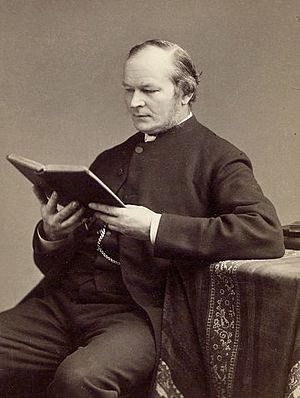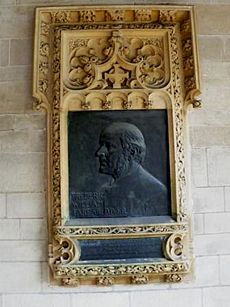Frederic Farrar facts for kids
Quick facts for kids
Dean Frederic William Farrar
|
|
|---|---|
 |
|
| Born | 7 August 1831 Bombay, India |
| Died | 22 March 1903 (aged 71) Canterbury, Kent, England |
| Occupation | Cleric, writer |
| Alma mater | |
| Period | 19th century |
| Genre | Theology, children's literature |
| Subject | The Highest Heaven. Farrar commentary |
Frederic William Farrar (born in Bombay, India, on August 7, 1831 – died in Canterbury, England, on March 22, 1903) was an important leader in the Church of England. He was also a schoolteacher and a famous writer. He helped carry the coffin at the funeral of the famous scientist Charles Darwin in 1882. Farrar was a member of a special group called the Cambridge Apostles. He held important church roles, serving as the Archdeacon of Westminster and later as the Dean of Canterbury.
Contents
Early Life and Education
Frederic William Farrar was born in Bombay, India. He went to school at King William's College on the Isle of Man. Later, he studied at King's College London and Trinity College, Cambridge. While at Cambridge, he won a special award for his poetry in 1852.
After finishing his studies, Farrar became a teacher. He taught for several years at Harrow School. From 1871 to 1876, he was the headmaster of Marlborough College.
Church Career and Writings
Farrar spent much of his life working at Westminster Abbey. He became a canon there in 1876. He also served as the rector of St Margaret's, Westminster, which is a church right next to the Abbey. In 1883, he became the archdeacon of Westminster Abbey. Later, he was chosen to be the Dean of Canterbury. He also worked as a chaplain for the Royal Household.
Farrar was known for being a great speaker and writer. He wrote many books, including stories about school life. Two of his most famous school stories are Eric, or, Little by Little and St. Winifred's. These books showed what life was like for boys at boarding schools in Victorian England. He also wrote two historical adventure stories.
Farrar and Charles Darwin
Frederic Farrar was a very smart person who studied ancient languages. He was interested in how languages are related to each other. He even used Charles Darwin's ideas about how living things change over time to think about how languages developed. He had many discussions with another linguist, Max Müller, who did not agree with Darwin's ideas.
Even though Farrar was not fully convinced about biological evolution, he did not think it went against his religious beliefs. He believed that scientific ideas should be looked at based on science alone. Because of his work on languages, he was chosen to be a member of the Royal Society in 1866. When Charles Darwin passed away in 1882, Farrar helped get permission for Darwin to be buried in Westminster Abbey. He also gave the sermon at Darwin's funeral.
Religious Books
Farrar wrote many popular religious books. His book Life of Christ (1874) was very famous and was translated into many languages. He also wrote Life of St. Paul (1879). He contributed to a Bible commentary series, writing about the Gospel of Luke and the Epistle to the Hebrews.
Farrar had some different ideas about what happens after death. He believed that some people might be saved even after they die. He also spoke out against the old idea that the suffering of people in hell would entertain those in heaven. He wrote books like Eternal Hope (1878) and Mercy and Judgment (1881) to explain his views on heaven and hell. He was sometimes accused of believing that everyone would eventually be saved, but he always said this was not true. He felt it was not clearly stated in the Bible and that people's choices could affect their fate.
Family Life
On August 1, 1860, Frederic Farrar married Lucy Mary Cardew. They had ten children together: five sons and five daughters.
One of their daughters, Maud, married Henry Montgomery in 1881. Henry Montgomery later became a bishop in Tasmania. Their son, Bernard Montgomery, became a very famous military leader. He was known as 'Monty' and played a big role in the Second World War.
Dean Farrar passed away on March 22, 1903. He was buried in the cloister of Canterbury Cathedral. Today, there is a street named after him in Westminster, London, called Dean Farrar Street. There is also a memorial to him at St Margaret's Church in Westminster.
Fiction Books
- Eric, or Little by Little, a school story (1858)
- Julian Home, a college story (1859)
- St Winifred's, or The World of School (1862)
- Darkness and Dawn, or Scenes in the Days of Nero (1891)
- Gathering Clouds: A Tale of the Days of St. Chrysostom (1895)


